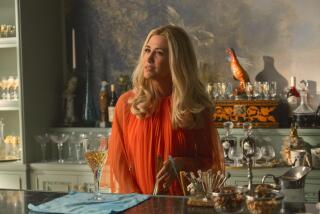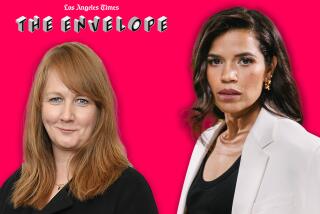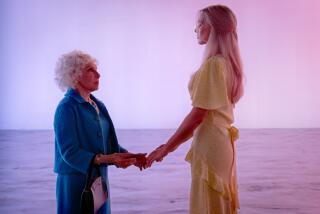Television review: âThe Playboy Clubâ
There is, no doubt, a tantalizing drama to be made about the early years of the Playboy Club, about the women who worked there and the men who patronized it, about Playboyâs influence on the sexual revolution and the often very fine line between sexual liberation and sexual exploitation. But NBCâs âThe Playboy Clubâ ainât it.
For all its âMad Menâ pretensions (which extend so far as casting Naturi Naughton, who played Laneâs bunny paramour in Season 4) and judge-not retro naughtiness, creator Chad Hodge doesnât have the courage of his convictions. âThe Playboy Clubâ is nothing but a tarted-up mob drama; the bunnies may be used as the marketing and milieu but the main narrative is about the men, and no one seems aware of the irony.
Which makes âThe Playboy Club,â if nothing else, a good example of one danger of our current surrender to nostalgia: the kitschification of sexism.
We meet callow new bunny Maureen (Amber Heard) as she is dreamily admiring the vocal talents of power bunny Carol-Lynne (Laura Benanti), only to be advised by nice bunny Alice (Leah Renee) and sassy bunny Brenda (Naughton) to get back to her cigarette bunny duties.
But the action doesnât start until Maureen catches the eye of Nick Dalton (Eddie Cibrian). Nick Dalton, now thereâs a name, and what a guy â Chicagoâs hottest young politico who, within minutes, saves Maureen from a supply closet attack by a creepy patron who Maureen accidentally, and rather hilariously, kills in the process. But this isnât just any creepy patron, this is a connected creepy patron, and so Nick and Maureen quickly develop the sort of sexy bond created whenever you dump a mobsterâs body into the river together.
B-plots arise as B-plots must â Maureen refuses to give up her Chicago dreams; Carol-Lynne fights with manager Billy (David Krumholtz) for power in the club; Alice has a Big Secret and Brenda dreams of being the âfirst chocolate centerfoldâ â but Nickâs career, past and present, defines the show. Hodge doesnât seem quite sure of what to do with all those bunnies beyond parading them and their cantilevered bosoms around and then self-righteously showcasing some of the humiliations the women must endure to embody every manâs fantasy.
The showâs blatant attempt to have it both ways is perfectly captured when Hugh Hefner, who opens and closes the pilot in voice-over, explains why his ethos was just as liberating for women as for men: âIt was the 1960s, and the bunnies were some of the only women in the world who could be whoever they wanted to be.â
This is patently absurd â the bunnies may have been better paid than their non-cotton-tail-wearing counterparts, but they were uniformed waitresses, for heavenâs sake, chosen for their homogenous bustiness, taught how to stand and walk and dip a certain way, and controlled by a demerit system. But it is an argument that is often made in any context in which a womanâs sex appeal is a coin with which she trades. Never was it argued louder than in the late â50s and early â60s, when the nascent modern womenâs movement was defined by both âThe Feminine Mystiqueâ and âSex and the Single Girl.â
Which should, in theory anyway, make for great television.
Most modern television shows assume a certain gender parity, making the sexual stakes increasingly discrete and personal â will this seemingly mismatched pair overcome their separate neuroses and find love? In many cases, the traditional roles have been reversed, with women portrayed as tightly wound, breadwinning multi-taskers and men as slacker-boys, dazed by the responsibility of adulthood.
So itâs not surprising that, as âMad Menâ proved, Americans were happy to be entranced by a show that bathes our past foibles in the golden light of nostalgia. A drama set in the early â60s threw sexual dynamics into broad relief â men really were in control and women literally defined by biology. The networks could not wait to catch up, with âThe Playboy Club,â ABCâs âPan Amâ and reboot of âCharlieâs Angelsâ (âonce upon a time, there were three little girlsâ); even the BBC got into the act with the miniseries âThe Hour.â
All of them share a desire to show, one way or another, just how tough it was for a woman in a manâs world. And in its finest moments, a period piece can show us how much we have changed, how much we have not and perhaps even why.
At its worst, it renders real issues quaint and decorative, turning, say, a womanâs inability to walk through her place of employment without being fondled into a bit of retro kitsch, like skinny ties or beanbag ashtrays. The upcoming âPan Amâ also argues, much more convincingly, that being a stewardess offered women freedom that their other, limited, choices did not. But still the women exude a sexuality (not to mention muscle tone) that is decidedly modern, and while much is made of the outrageous requirement that stewardesses wear girdles, the camera lingers lovingly over their sleek silhouettes, turning their neat little figures into just another graphic device of the period, like the Pan Am logo or the inevitable martini glass.
Thereâs nothing wrong with playing a little dress-up now and again, said the French maid to the vicar, but it helps when a show has substance and direction. âThe Playboy Clubâ has neither, which makes its âcelebrationâ of the bunnies even more shameful, like putting the rag back on Aunt Jemimaâs head.
More to Read
The complete guide to home viewing
Get Screen Gab for everything about the TV shows and streaming movies everyoneâs talking about.
You may occasionally receive promotional content from the Los Angeles Times.







